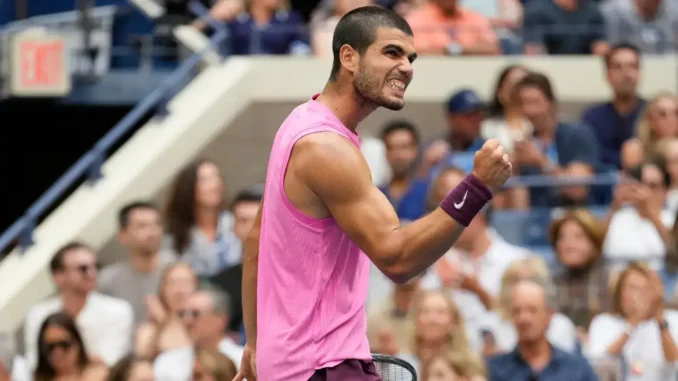
Carlos Alcaraz Storms Into Japan Open Semifinal, Holger Rune Crashes Out After Epic Upset:
The 2025 tennis season has produced some captivating narratives, and the Japan Open in Tokyo has quickly become one of its most intriguing stops. The tournament is traditionally a stage where rising stars clash with seasoned campaigners, but this year’s edition has offered even more drama than expected. On one end, Carlos Alcaraz continues to prove why he is widely regarded as the future — and increasingly, the present — of men’s tennis. On the other, Holger Rune suffered a stunning defeat in an upset that has shaken up the draw and highlighted the fine margins of elite competition. The contrasting fates of these two young stars have fueled conversations around the shifting balance of power in the sport.
Alcaraz’s Dominant March:
Carlos Alcaraz entered Tokyo brimming with confidence after a strong late-season push that has reinforced his reputation as Novak Djokovic’s most formidable successor. Facing a determined quarterfinal opponent, Alcaraz wasted no time imposing his trademark aggressive baseline game. His powerful forehand, precise backhand down the line, and fearless net play combined to dismantle his challenger in straight sets, securing his place in the semifinals.
The Spaniard’s performance once again highlighted the maturity he has developed at just 22 years of age. Whereas in previous seasons Alcaraz occasionally faltered under pressure, this week he has looked unflappable. His serve has been firing with consistency, producing both aces and unreturnable deliveries that give him free points when needed. Just as importantly, his defensive skills — sliding on hard courts to retrieve balls that seem out of reach — continue to leave both opponents and spectators in awe.
Alcaraz’s Tokyo run also underscores his ability to adapt across surfaces and continents. Winning on the Asian swing is no small feat; the travel, time zone shifts, and indoor hard-court conditions can unsettle even the most experienced players. Yet, Alcaraz has managed the transition seamlessly, looking as sharp in Japan as he did earlier in the summer on European clay and North American hard courts.
His progress into the semifinals puts him within striking distance of another ATP title, which would strengthen his bid for the year-end No. 1 ranking. It also sends a clear message to his rivals: Alcaraz is not slowing down and remains hungry for silverware.
Rune’s Stunning Exit:
If Alcaraz’s journey was about dominance, Holger Rune’s Tokyo story became one of unexpected collapse. Entering the tournament, Rune was tipped as one of the dark horses. The Danish prodigy, still only 22 but already seasoned with deep runs at Grand Slams and Masters 1000 events, was expected to mount a serious challenge for the title. However, he crashed out in the quarterfinals after being upset in a dramatic three-set battle that stretched well over two and a half hours.
Rune’s opponent, a lower-ranked but fearless competitor, exploited the Dane’s inconsistencies. While Rune produced flashes of brilliance — booming forehands, delicate drop shots, and moments of fiery resilience — his serve betrayed him at critical junctures. Double faults crept into his game, and his first-serve percentage dipped alarmingly in the decider. The crowd, sensing an upset, rallied behind the underdog, who seized the momentum and held his nerve to clinch the win.
For Rune, this loss will sting. He has built a reputation as a player who thrives in high-intensity encounters, often elevating his game against top opposition. Yet, this match served as a reminder that even elite talents must constantly refine their mental and tactical approaches. Rune admitted afterward that he felt “out of rhythm” and struggled to find the balance between aggression and control.
This exit not only dents Rune’s Tokyo campaign but also adds pressure as the season draws to a close. With ranking points at stake and the ATP Finals looming, Rune will need to regroup quickly to avoid slipping further behind rivals like Alcaraz and Jannik Sinner.
The Broader Implications:
The diverging fortunes of Alcaraz and Rune in Tokyo illuminate the unpredictable nature of men’s tennis in this new era. While Alcaraz continues to fulfill the lofty expectations placed upon him, Rune’s journey shows that the path to consistency at the highest level remains fraught with challenges. Both players symbolize the next generation, yet their week in Japan is a reminder that not all rising stars ascend in a straight line.
The semifinal lineup, now altered by Rune’s departure, opens opportunities for other contenders to step into the spotlight. Fans in Tokyo and around the world are eager to see whether Alcaraz can maintain his blistering form and capture the title, or if another player will rise to the occasion and author their own upset.
For the sport as a whole, the Japan Open’s unfolding drama is a gift. It offers a glimpse into the dynamics that will define the coming years: the brilliance of Alcaraz, the volatility of Rune, and the relentless competition from both established veterans and ambitious newcomers.
Conclusion:
Carlos Alcaraz’s storming run into the semifinals of the Japan Open reinforces his status as one of the defining players of this generation. His blend of power, finesse, and mental fortitude has carried him past every obstacle so far, and he now stands on the brink of adding another title to his growing collection. Meanwhile, Holger Rune’s shock exit is a cautionary tale about the volatility of tennis at the highest level. While Rune’s talent is undeniable, the consistency required to match players like Alcaraz remains a work in progress.
As Tokyo’s tournament heads into its decisive stages, the spotlight will burn even brighter on Alcaraz. Whether he lifts the trophy or not, his performance has already made a statement: the next era of tennis is not just coming .

Leave a Reply